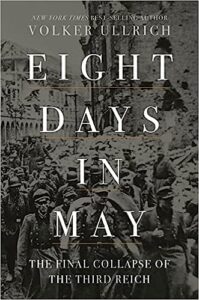GIs OVERWHELMED BY DACHAU CONCENTRATION CAMP HORRORS
Dachau, Germany • April 29, 1945
On a gray last Sunday in April 1945, 10 miles/16 kilometers north of Munich, Bavaria’s capital, U.S. soldiers of the 42nd Infantry Division, nicknamed the “Rainbow Division,” the 45th “Thunderbird” Infantry Division, and the 27th Tank Battalion were overwhelmed by the horror they saw as they closed in on Dachau concentration camp and even more so on entering the complex. For the first time in their lives these battle-hardened men of Gen. Alexander Patch’s Seventh Army smelled and viewed their worst nightmare. Approaching Southeastern Germany, these greenhorn “camp liberators”—for the most part “grunt soldiers” who had seen 500 days of combat—had no inkling of what they might face nearing or entering a German prison camp.
Following a rail siding a few infantrymen from the 42th Division stumbled across the “Dachau Death Train,” as it is known to posterity. Abandoned on the siding were about 40 boxcars and gondola cars chuck-full of emaciated corpses of 2,000–2,300 innocent, mostly Hungarian Jews. The unfortunate souls had been evacuated 3 weeks earlier from Buchenwald concentration camp northeast of Dachau. The gut-wrenching stench and sight of half-clothed prisoners in ghoulish death poses—dehydrated, asphyxiated, and starved to death on a murderous 250‑mile/400‑kilometer odyssey to Dachau—caused GIs with quivering stomachs to empty them immediately. Some with stronger stomachs seethed with blind rage while a handful plotted to take revenge on the supposed perpetrators (see photo essay below).
Holocaust literature has covered the vileness of Nazi concentration, slave labor, and extermination camps: e.g., the severe overcrowding, physical and mental exhaustion, malnutrition, disease (mainly typhus), bestial cruelty and floggings, exposure, deadly medical experiments, starvation, execution, gassing, corpses cremated in ovens or over fire pits burning cordwood or coal. Extensive coverage is as it should and must be. Less extensive coverage has been accorded camp liberators who were traumatized, often for life, while rescuing prisoners, helping gather up the dead, and nursing survivors to health with clean water, adequate food, and medical attention. Nervous breakdowns, recurrent nightmares, melancholy, detachment, silence, drug and alcohol abuse—such were some of the consequences of GIs bearing witness to camp liberation.
The total number of Nazi camps and satellite camps exceeded 5,000. Dachau, with a recorded intake of 206,206 prisoners during its existence, was the oldest German concentration camp. It opened less than 2 months after Nazi Party leader Adolf Hitler became German chancellor in January 1933. In time Dachau’s camp system grew to include nearly 100 satellite camps, mostly forced labor work camps that were spread over Southern Germany and Austria.
More than 250,000 GIs became unwitting witnesses to the horror of German concentration, slave labor, and death camps. Supreme Allied commander Gen. Dwight D. Eisenhower ordered his soldiers from every battalion within 50 miles/80 kilometers of a discovered camp to send soldiers to bear witness. Eisenhower sadly foresaw a time when there would be many “Holocaust deniers.” By his edict he believed that the average GI would understand not just what he was fighting for but “he will know who he is fighting against.” His edict applied equally to German residents in surrounding communities. One Dachau liberator with the 42nd Infantry Division recounted his eyewitness story to an interviewer: “It was as if I had entered hell. . . You just couldn’t believe it,” all the while rubbing his hands over and over each other. “My mind froze; the shock was complete and total. Especially when we saw the crematoria—it [sic] was still hot, with these piles of bodies stacked five bodies high.” Camp records assert 41,500 inmates were killed at Dachau. In the closing days of war a select group of U.S. congresspersons and members of the print and broadcast media toured the camps with the intent to inform stateside and international audiences about the Nazi “death mills.”
Bearing Witness: What It Was Like in Hell
 |  |
Left: Provisioned with little food or water the Dachau Death Train of approximately 40 boxcars sits at a siding near the camp entrance. Upon their arrival at the prison camp only 1,300 living skeletons out of some 5,000 inmates who had departed Buchenwald concentration camp 250 miles/400 kilometers to the northeast were able to shuffle the short distance from the rail spur to the prison compound where 30,000 inmates, in dire condition, hoped for the swift arrival of the Americans.
![]()
Right: U.S. medics check for signs of life in a gondola (open-top) rail car left on a siding outside Dachau concentration camp on April 29, 1943. Over 2,300 decomposing human remains were found on the Death Train, which had departed Buchenwald concentration camp just days before U.S. armed forces captured the camp. Buchenwald was about 4.5 miles/7 kilometers northwest of the city of Weimar in Thueringen, Eastern Germany.
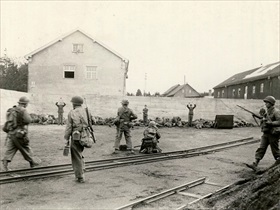 |  |
Left: Thrown off balance by the sight of starvation, cruelty, bestiality, and death all around them on the day of Dachau’s liberation, a small group—no more than 10—from the 45th (Thunderbird) Infantry Division, brandishing rifles, pistols, and a BAR 30‑caliber/7.62‑millimeter machine gun, summarily executed at least 17 Schutzstaffel (SS) and assorted German military prisoners. Totaling around 100 prisoners standing against an 8‑foot/2.4‑meter stucco wall, the dying and wounded collapsed to the ground in a coal yard next to the prisoner camp’s heating plant. (Click here to read more about this terrible incident in Alex Kershaw’s The Liberator: One World War II Soldier’s 500‑Day Odyssey from the Beaches of Sicily to the Gates of Dachau.) Cheers rang out from thousands of camp onlookers. Many of them beat SS guardsmen, informers, and prison trustees known as Kapos (inmates who were given privileges in exchange for supervising prisoner work gangs) to bloody pulps or to death with fists, sticks, and shovels. Few of their liberators intervened in the revenge killings. A private with the Thunderbirds recalled liberation day: “I don’t think there was a guy who slept that night, and I don’t think there was a guy who didn’t cry openly that night.”
![]()
Right: Bodies of SS personnel laid out alongside a road in Dachau concentration camp, April 29, 1945. The SS-Totenkopfverbaende (SS-TV; lit. “Death’s Head Units”) was the brutal and fanatical SS organization responsible for administering Nazi concentration and extermination camps. SS men and women had the assistance of Kapos and Jewish Sonderkommandos, the latter helping with the disposal of bodies and other tasks. SS persons and their non-SS camp adjutants bore the brunt of inmate revenge after many of their colleagues fled their beleaguered posts as Allied forces rapidly approached their camps.
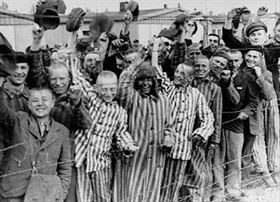 | 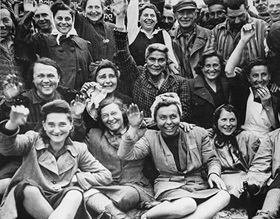 |
Left: Liberated Dachau inmates cheer U.S. troops. Many broke into tears of joy, laughed, danced, and sang their national anthems—there were more than 30 nationalities (one source put the number at 40) at the sprawling Dachau complex. Two-thirds of the inmates were political prisoners, including 1,000 Catholic priests. Polish prisoners were the majority of the prisoner population (at 9,082) followed by Soviet POWs (4,258) until Dachau’s liberation.
![]()
Right: Female prisoners at Dachau wave to their liberators. On April 26, 1945, as American forces approached, there were 67,665 registered prisoners in Dachau and its subcamps, 31,432 in the main camp (KZ Dachau). Of these, 43,350 were categorized as political prisoners, while 22,100 were Jews, with the remainder falling into various other categories.
 |  |
Left: As a rule camp liberators recoiled in disbelief when they heard the perpetual lament of visiting townspeople, who gaped in horror at the piles of decaying bodies and breathed in their putrid stench: “Wir wussten nicht.” (We didn’t know.) “Niemand sagte uns.” (No one told us.) The object of what Germans didn’t know or weren’t told (i.e., the missing “it” in sentences like these) was belied most often by, first, the one-way traffic of tens of thousands of locked rail cars leaving from or passing through German cities, towns, and villages to out-of-the-way destinations where many of the concentration and death camps were located and, secondly, the sooty smoke rising from crematoria chimneys, floating long distances over the Reich landscape, the ash settling on trees turning leaves gray. Some of the townspeople and others like them in this picture who solemnly swore they didn’t know, were never told, never saw anything out of the ordinary were conceivably the same people who years or months or weeks earlier had jeered, hurled insults, and spat on camp arrivals who tragically ended up dead on crematoria floors like this one in Ohrdruf, a Buchenwald subcamp liberated on April 4, 1945.
![]()
Right: Combat-hardened soldiers oversee Dachau residents retrieving and burying camp victims. The previous fall more than 15,000 internees had died in a typhus epidemic caused by poor sanitation and overcrowding, their green- and yellow-skinned bodies had been left to rot in piles and pits. U.S. military authorities ordered nearby communities to either provide burial services (“forced assistance”) or partake in mind-boggling walk-throughs of squalid camp barracks or crematoria with open-door ovens or beside open slit trenches filled with putrefying corpses. This stratagem ensured that as many as possible of those living in the vicinity of Dachau could bear witness to the until-then unimaginable evil committed by their government.
Contemporary Footage of Dachau Concentration Camp’s Liberation, April 29, 1945
![]()

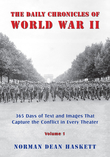 History buffs, there is good news! The Daily Chronicles of World War II is now available as an ebook for $4.99 on Amazon.com. Containing a year’s worth of dated entries from this website, the ebook brings the story of this tumultuous era to life in a compelling, authoritative, and succinct manner. Featuring inventive navigation aids, the ebook enables readers to instantly move forward or backward by month and date to different dated entries. Simple and elegant! Click
History buffs, there is good news! The Daily Chronicles of World War II is now available as an ebook for $4.99 on Amazon.com. Containing a year’s worth of dated entries from this website, the ebook brings the story of this tumultuous era to life in a compelling, authoritative, and succinct manner. Featuring inventive navigation aids, the ebook enables readers to instantly move forward or backward by month and date to different dated entries. Simple and elegant! Click 











